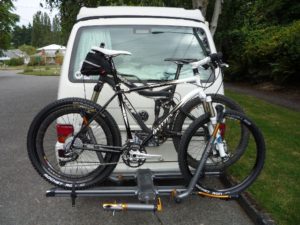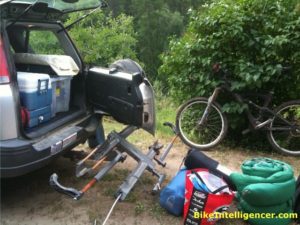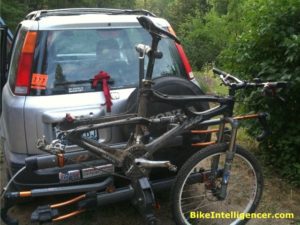At Interbike 2009, the big bike rack buzz came from a tiny David v. Goliath maker with some fresh ideas. David was Kuat (Thule being Goliath of course), the rack was called the NV, and the fresh ideas were built-in cable locking and a truly cool bike stand for repairs on a road trip.
Kuat wound up sending us a unit for review. The occasion of this week’s Interbike gave us the opportunity to present a “one year later” look at Kuat’s flagship rack. We’ve also been told to expect a big announcement at this year’s Interbike from Kuat as well.
We put our rack through the ringer. We logged more than 2,000 miles on it in less than a month. We took it across three states, up eroded 9-mile fire roads, over ungraded dirt access roads, across boggy meadows. We drove over brutal water bars at 8,000 feet elevation. We hit potholes the size of wading pools. We banged over rock gardens laced with boulders resembling cannonballs.
We whacked it, slammed it, used it and abused it. Through it all, the NV barely blinked. Bouncing over gullies and washouts, getting tossed around like an kayak in rapids, we would check in the rear view mirror to see how the bikes were doing. Based on experiences with Softride and Saris and Thule T2 racks, we expected to see some movement. Some shaking or wiggling or swaying.
Nada. The NV held solid. Kuat (the name comes from the first two initials of the co-founders last names) rode our buckin’ broncos — a Honda CR-V and Volkswagen Eurovan — all over the corral, barely even breaking a sweat.
[After we finished our testing, news came that some NVs were being recalled for an issue with the wheel cups. We checked and were not surprised to find our rack a later iteration than the suspect units. If there were a flaw in our rack, we think we would have noticed. Kuat addressed the issue some time ago but decided on the recall to be on the safe side. We wish Thule, whose T2 we own but feel has some dangerous albeit easily fixable design issues, were as proactive in its recall policy.]
The NV arrived unassembled. Assembly tools and hardware are included. It took us a little more than an hour from unpacking to final kit, which would’ve gone much faster with a ratchet wrench that fit the mounting bolts (8mm head).
The Kuat NV represents a laudable step up in platform hitch rack technology. The first thing you notice is its beefier and safer construction. The trays bolt (rather than slide) onto the hitch spar. They’re nicely molded, painted and polished. The rack weighs 8 pounds more than the T2 (45 v. 37 lbs.), but in this case the extra weight is worth it. The thing feels solid.
The rack uses an expansion cam to snug into the hitch, an approach we wondered about at first but came to really appreciate. After lining up the mount with the hitch hole, you slip in a steel pin and sleeve, securing the pin with a supplied cover lock. Then you turn a knurled knob on the outer end of the spar to engage the expansion mechanism. A supplied Allen wrench completes the procedure.
We originally thought the cam meant no 4-bike configuration (2 additional trays) for the NV. But Kuat has begun offering a 2-bike add-on option.
The cam provides far less slop than the conventional screw-in bolt used by other racks. With the bolt you simply can’t get the same purchase as Kuat’s innovative expansion technology. The “Kuat grip” helps explain why this rack moves so much less than others under duress.
We liked a number of other things.
The rack’s configuration puts it 2-plus inches higher off the road than the T2. This kept us from whacking the rack even on gnarly dirt ascents at speed.
The support arms have a broader, rubberized top hook (clamp) that more fully engages the front tire. The NV comes with attachments enabling the arms to accept 20-inch wheels. The rear-wheel straps have slip-through fasteners that can be threaded and pulled tight with just one hand (most racks have buckles requiring two hands). Overall, mounting bikes on the NV is the quickest and easiest we’ve encountered.
There’s no rear wheel cup, just the scooped surface of the tray. We wondered if this were less secure until we forgot to strap one of the bikes in. Hours (and miles) later we discovered our error, but the unstrapped wheel hadn’t budged from the middle of the tray.
The ratchet mechanism on the support arms was a bit sticky but held like a vise. It’s released with a plastic button that didn’t always release easily and seemed like the only cheap part on the rack (tip: for easier release, push the hook down as you engage the button). The arms themselves are burly and tight — again, giving the feeling of a secure, stable fit.
Our only other minor gotcha had to do with the rack position release. It’s a bit difficult to reach and tricky to engage (we kept expecting it to break in and it may very well with more use, but it was kind of balky). Other racks we’ve used, including Thule’s, make changing rack position a lot easier.
You can also lower the NV (like the T2) at an angle away from the vehicle for access to rear window and hatches. It worked like a charm on the CR-V and a Subaru; the Eurovan’s rear door is too big and low. (But aside from the Softride, that’s been true of other racks we’ve used.)
There are two particularly tasty bits on the NV. It has a built-in locking cable we really loved. The cables emerge from opposite tray ends and secure through the bikes’ rear triangles with an attached lock. They’re probably not enough to protect bikes overnight, say, or in a big unguarded parking lot. But for everyday use they’re wonderful. When not in use they slide into recessed slots out of sight. A nice touch: Magnets hold the cable ends in place so they don’t pop out and drag on the pavement.
Then there’s the built-in bike repair stand, which Kuat calls its “Trail Doc.” For our 10-day Idaho sojourn this was a life-saver. You simply close the rack (upright), extend a post with quick-release and use the seat-post clamp to secure your bike. You can do everything from simple maintenance like chain lubing or cable adjustment to wheel removal, bottom bracket overhaul, whatever. The pedals don’t catch on the rack, there’s plenty of room to work, and the bike is high enough that you don’t have to do the entire job bending over.
We wondered about a couple of things even though we encountered no problems. When the rack is not in use and placed upright (against the rear), the knurled tightening knob is rear-most exposed. We wondered how it would hold up being whacked by the bumper of another car. (MTBR.com’s reviewer broke off the knob driving off a curb.) The same thing goes for when the rack is loaded, only in that case the Trail Doc hardware is exposed. In any case, the rack comes with a lifetime warranty. We ran into a longtime Kuat customer at Galbraith Mountain who said Kuat had replaced his rack (not an NV) twice with no questions asked.
Retailing at $495, the NV is a bit pricier than other racks. But you’re getting more features, better construction, more stability, safer operation and an overall better product. When you’re out on the road or doing a trailhead repair with the NV, you won’t miss those Andrew Jacksons one bit.
Bottom line: This is the best platform rack out there. The detail work, thoughtful construction and cool features make it more than just a bike carrier. It’s like an all-around bike butler, capable of attending to your bike’s every need.
Kuat NV comparison with Thule T2
[Note: T2s have recently become unavailable from some leading outlets, prompting speculation that Thule will offer an upgraded model to be unveiled at the upcoming Interbike show in Las Vegas. We’ll keep readers posted.]
- Design: Kuat’s arm hooks are broader and more curved, offering more contact with tires. Thule’s more pronounced hooks have a tighter angle, less tire contact. Kuat’s design is more stable, we feel.
- Adjustability: Thule’s trays slide along main spar, offering more options for bike-to-bike clearance. But we’ve also reported a number of catastrophic failures with the T2 due to this feature. BikeIntelligencer supports a recall of the rack to address this flaw in the T2. Kuat’s trays are fixed.
- Construction: Kuat is a significant 8 lbs. heavier. The tradeoff is greater strength and stability, particularly noticeable in the trays.
- Rack release: Kuat’s side release was a bit balky and harder to reach. Thule’s top-release lever is smoother and more accessible.
- Positioning: Kuat rides 2-plus inches higher off the ground, offering better clearance. Kuat’s overall length is six inches shorter. Both contribute to its added stability.
- Finish: Kuat’s distinctive orange and gray, in addition to paint and clear coat, give it the nod over Thule in the looks department.
- Features: Kuat offers a bike maintenance stand and built-in locking cable. (The latter feature is rumored to be included in a forthcoming update of the T2.) Thule offers locking support arms, but this feature is easily defeated by deflating the front tire.
[NOTE: With few exceptions as noted, our policy at BikeIntelligencer is to pay for what we review. In this case, Kuat offered us a rack for review that we liked so much we asked if we could buy it. Kuat asked us to donate the equivalent funds to a worthy cause of our liking, which we will split between the Evergreen Mountain Bike Alliance in Seattle and IMBA.]

Great review, very thorough and you covered all the important points. You mentioned a rumored design change on the Thule T2, I’m looking at the 2011 Spring Dealer Guide from Thule and you’re absolutely right. The T2 will include an integrated locking cable that extends from the ratchet arm to lock around the bike frame. Expected availability, February 2011.
We tried another rack before buying the kuat. It was tricky using the lock when the bikes were on – locking to the hitch. It rained when we were camping and now the rack was going to start rusting. (When returning it to the store, the sales person told me I wasn’t supposed to leave the rack on the car, I was supposed to take it off and put it in the trunk!) The kuat is finished, I’ve had it on my car all summer, no rust. I can get in between the rack and my car to open my trunk. Even the store owner where I purchased it from was impressed when I went back to show him what it looked like on the car. Absolutely worth the extra $50 for the upgrades – the lock is slick, slide in, slide out. I’ve gotten many curious stares from other biking cars. They are admiring my rack and wondering where they can get one! I love my kuat!